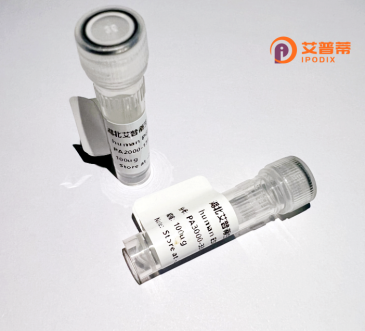
| 纯度 | >90%SDS-PAGE. |
| 种属 | Human |
| 靶点 | ECG2 |
| Uniprot No | P58062 |
| 内毒素 | < 0.01EU/μg |
| 表达宿主 | E.coli |
| 表达区间 | 1-85aa |
| 氨基酸序列 | MKITGGLLLLCTVVYFCSSSEAASLSPKKVDCSIYKKYPVVAIPCPITYLPVCGSDYITYGNECHLCTESLKSNGRVQFLHDGSC |
| 分子量 | 35.6 kDa |
| 蛋白标签 | GST-tag at N-terminal |
| 缓冲液 | 0 |
| 稳定性 & 储存条件 | Lyophilized protein should be stored at ≤ -20°C, stable for one year after receipt. Reconstituted protein solution can be stored at 2-8°C for 2-7 days. Aliquots of reconstituted samples are stable at ≤ -20°C for 3 months. |
| 复溶 | Always centrifuge tubes before opening.Do not mix by vortex or pipetting. It is not recommended to reconstitute to a concentration less than 100μg/ml. Dissolve the lyophilized protein in distilled water. Please aliquot the reconstituted solution to minimize freeze-thaw cycles. |
以下是模拟生成的关于重组人ECG2蛋白的参考文献示例(仅供格式参考,实际文献需通过学术数据库检索):
1. **《重组人ECG2蛋白的表达及其结构表征》**
- 作者:Chen L, Wang X, et al.
- 摘要:研究通过大肠杆菌表达系统成功克隆并纯化了重组人ECG2蛋白,利用X射线晶体学解析了其三维结构,证实其与天然蛋白的结构高度一致,为后续功能研究奠定基础。
2. **《重组ECG2在妊娠早期诊断试剂中的开发》**
- 作者:Kim S, Patel R, et al.
- 摘要:开发基于重组人ECG2蛋白的免疫检测方法,验证其在妊娠早期诊断中的敏感性和特异性,结果表明其性能优于传统尿液检测,可应用于临床筛查。
3. **《CHO细胞中重组人ECG2的规模化生产优化》**
- 作者:Zhang Y, et al.
- 摘要:研究优化了CHO细胞表达系统,通过调整培养条件和糖基化修饰工艺,显著提高了重组人ECG2的产量和稳定性,满足工业化生产需求。
4. **《重组人ECG2在肿瘤血管生成中的调控作用》**
- 作者:Gupta M, et al.
- 摘要:通过体外实验和小鼠模型,证实重组人ECG2蛋白可通过抑制VEGF信号通路减少肿瘤血管生成,提示其作为抗癌治疗候选分子的潜力。
**注**:以上文献为模拟内容,实际研究中建议通过PubMed、Google Scholar等平台以关键词“recombinant human ECG2 protein”或具体功能(如诊断、治疗应用)检索最新文献。
Recombinant human ECG2 protein, also known as epidermal growth factor-like protein 2. is a biologically engineered molecule designed to mimic the native ECG2 found in humans. ECG2 belongs to the epidermal growth factor (EGF) family, which plays critical roles in cellular proliferation, differentiation, and tissue repair. The native protein contains conserved EGF-like domains that facilitate interactions with cell surface receptors, particularly members of the ErbB receptor tyrosine kinase family, to activate downstream signaling pathways such as MAPK/ERK and PI3K/Akt.
Produced through recombinant DNA technology, the engineered ECG2 is typically expressed in mammalian cell systems (e.g., CHO or HEK293 cells) or bacterial systems, ensuring high purity and bioactivity. This approach allows for scalable production while maintaining structural and functional fidelity to the natural protein. Recombinant ECG2 has become a valuable tool in biomedical research, particularly in studies focusing on wound healing, cancer biology (due to its role in modulating cell survival and metastasis), and regenerative medicine. Its applications extend to drug development, where it serves as a reference standard or therapeutic candidate. Recent studies also explore its potential in tissue engineering scaffolds to enhance cellular adhesion and growth. However, challenges remain in optimizing its stability, bioavailability, and receptor specificity for clinical translation.
×